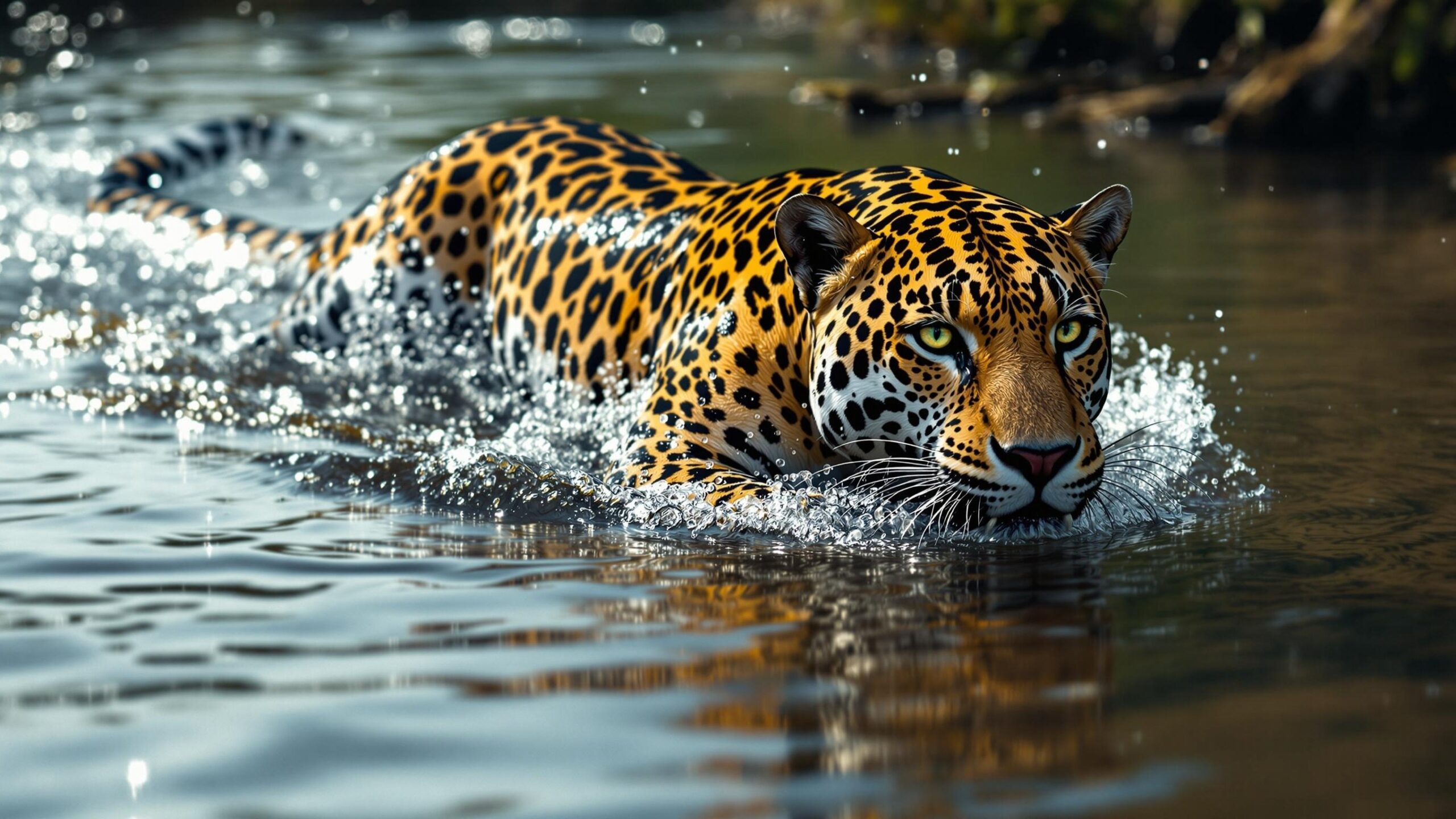Jaguars: The Silent Kings of the Rainforest and Masters of the Americas
Deep in the emerald heart of the rainforest, where shadows dance on fallen leaves and rivers coil like snakes through ancient jungle, a pair of golden eyes pierces the dusk. With a slow, calculated stride, a figure emerges—a creature at once regal and ruthless. The jaguar, draped in golden fur marked with dark rosettes, is not just a predator. It is a legend. Revered by ancient civilizations, feared and admired by all who have crossed its path, the jaguar is one of nature’s most enigmatic and powerful big cats. More than a symbol of raw strength, it represents the spirit of the jungle itself—stealthy, sovereign, and sacred.
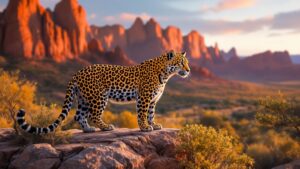
American Jaguar
American Jaguar: The Phantom of the Americas Deep within the sun-dappled forests and whispering canyons of the Americas roams a beast as elusive as it is awe-inspiring. With golden fur cloaked in black rosettes and muscles forged by centuries of evolution, the American jaguar (Panthera onca) holds the title of the largest feline in the Western Hemisphere. Revered by ancient civilizations, feared by its prey, and admired by biologists and
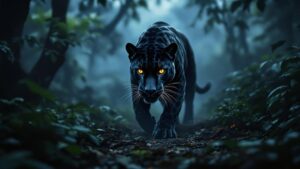
Black Jaguar
The Black Jaguar: Nature’s Elusive Phantom The Black Jaguar (Panthera onca) stands among the most enigmatic and awe-inspiring creatures of the animal kingdom. As a melanistic variant of the jaguar, this shadowy predator exudes mystery and raw power, captivating all who glimpse its dark silhouette slinking through the rainforests of the Americas. With its gleaming, charcoal-hued coat and piercing golden eyes, the black jaguar has become the subject of countless
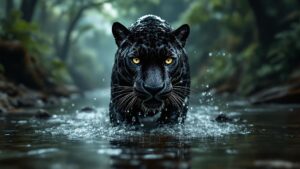
Black Panther
Black Panther: Nature’s Elusive Shadow In the misty forests of Southeast Asia, the dense jungles of Africa, and the lush landscapes of South America, a shadowy figure moves silently through the undergrowth. With piercing eyes, graceful movements, and a coat as dark as midnight, this rare and mysterious creature has long captivated the human imagination. Known collectively as the Black Panther, these animals are not a distinct species, but rather
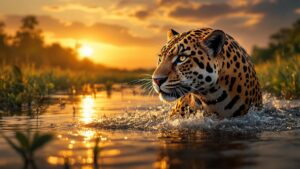
Pantanal Jaguar
Pantanal Jaguar: Apex Predator of South America’s Wild Heart Deep in the lush, watery expanse of the Pantanal, the world’s largest tropical wetland, prowls a master of stealth and strength—the Pantanal jaguar. Known scientifically as Panthera onca, this powerful big cat is a subspecies of jaguar adapted to life in a sprawling ecosystem unlike any other. Revered for its size, swimming prowess, and bold nature, the Pantanal jaguar has become
Unmatched Power and Solitude: What Makes the Jaguar Unique
Scientifically known as Panthera onca, the jaguar is the third-largest big cat in the world, following the tiger and the lion, and the largest in the Americas. Jaguars are built like tanks—stocky, muscular, and capable of delivering the most powerful bite of any big cat relative to body size. That bite is strong enough to crush the skulls of capybaras and pierce the armored shells of turtles. Unlike other cats that prefer a throat bite, jaguars kill by driving their fangs directly into the skull or spine, a brutal method that highlights their unmatched predatory prowess.
Jaguars are generally solitary, roaming vast territories that range from dense rainforests and wetlands to scrublands and arid deserts. Their territories are marked with scent trails and claw marks on trees, maintained with fierce determination. They are excellent swimmers, often found along riverbanks and flooded forests. Unlike many big cats, they revel in water, stalking fish, caimans, and anacondas with the same precision they use on land.
The pattern on a jaguar’s coat—a complex array of rosettes, each unique like a fingerprint—not only provides camouflage but also distinguishes them from their close cousins, the leopard. Jaguars tend to be more heavily built, with shorter limbs and broader heads, suited for their explosive power and forest-based lifestyle. Their senses are fine-tuned for night hunting, making them effective nocturnal predators in dense, humid environments.
Amazon Jaguars: Apex Predators of the World’s Greatest Rainforest
The Amazon rainforest, the world’s largest tropical forest, is the crown jewel of jaguar habitat. Here, the jaguar reigns supreme as the apex predator. In this vast labyrinth of life, where trees reach toward the heavens and rivers mirror the skies, jaguars stalk silently through tangled undergrowth and along shadowy waterways. Their diet is incredibly diverse, ranging from monkeys and sloths to tapirs and peccaries, as well as aquatic prey like fish and caimans.
These jaguars play a critical role in maintaining ecological balance. By keeping herbivore populations in check, they ensure the forest understory isn’t overgrazed, allowing new plant life to flourish. This cascading effect sustains the health of the entire rainforest ecosystem. Despite their ecological importance, Amazon jaguars face growing threats from deforestation, illegal hunting, and habitat fragmentation. As the Amazon burns and shrinks, so too does the realm of this majestic cat.
Conservationists are working to establish wildlife corridors that connect fragmented habitats, allowing jaguars to roam and mate freely across their range. Ecotourism and indigenous-led initiatives have also shown promise in safeguarding both the cats and the lands they call home.
Pantanal Jaguars: River Guardians of the Wetlands
The Pantanal of Brazil is the world’s largest tropical wetland, and it is also one of the best places on Earth to observe jaguars in the wild. Unlike their reclusive jungle cousins, Pantanal jaguars are more visible, often seen lounging along riverbanks or swimming across channels. This visibility has turned the region into a global hotspot for wildlife photography and jaguar research. Here, the jaguar’s aquatic abilities shine. They expertly hunt caimans, one of the few predators willing and able to take on such armored and dangerous prey. Documented cases show jaguars dragging adult caimans from the water, a testament to their strength and confidence. The abundance of prey and open landscape makes the Pantanal ideal for large male jaguars to hold extensive territories, often overlapping with several females. Conservation in the Pantanal is a race against time. Agricultural expansion, wildfires, and infrastructure development threaten to disrupt this intricate ecosystem. However, success stories in responsible tourism, scientific study, and local engagement offer a roadmap for how humans and jaguars might coexist—and even thrive together.
Maya Jaguars: Echoes of a Sacred Cat in the Forests of Central America
In the ruins of the Maya world, carved into stone temples and painted on sacred ceramics, the jaguar appears over and over again—not as an animal, but as a god. The ancient Maya believed the jaguar was a bridge between worlds, a creature that could travel between the realms of life and death, day and night. This reverence still lingers in the misty cloud forests and rainforests of Central America.
Jaguars in this region are deeply tied to indigenous culture and mythology. Biologically, they are no different from other jaguars, but their behavioral adaptations often reflect the terrain. These jaguars must navigate rugged mountains, fragmented forests, and encroaching development. They often prey on deer, agoutis, and armadillos, and must stay out of sight from human settlements to avoid conflict. Cross-border conservation initiatives like the Mesoamerican Biological Corridor are working to maintain passageways for jaguars from Mexico to Panama. Camera traps, GPS collars, and community-based monitoring have created a clearer picture of how jaguars live in this corridor and how they might be protected. In this region, the jaguar is both a relic of the past and a guardian of the future.
Northern Jaguars: Survivors at the Edge of Their Range
In the arid mountains and desert canyons of northern Mexico and the southern United States, jaguars hold on at the very edge of their historical range. Once found throughout the American Southwest, jaguars were nearly eradicated by hunting and habitat loss. Now, thanks to conservation efforts, a few individuals have been spotted in Arizona and New Mexico, wandering north from populations in Sonora, Mexico. These “borderland” jaguars are highly mobile, often traversing vast, rugged landscapes in search of mates and territory. They represent one of the most poignant conservation challenges for big cats—how do we protect and encourage a return of an apex predator in a landscape now dominated by roads, cities, and ranches?
The answer may lie in partnerships between private landowners, indigenous communities, and conservation groups. Initiatives like the Northern Jaguar Reserve aim to provide safe, uninterrupted space for these solitary cats. Their persistence in this marginal habitat is a symbol of resilience and a testament to the will of nature to reclaim what was lost.
Black Jaguars: Living Shadows in the Canopy
Black jaguars, often referred to as “black panthers,” are not a separate species or subspecies. Rather, they are melanistic individuals with a genetic mutation that causes excess dark pigmentation. In certain light, their rosette patterns are still visible beneath the black coat. These cats are rare and most often found in the dense rainforests of Central and South America, where their dark coloration offers a camouflage advantage. The presence of black jaguars has fueled countless legends, myths, and stories of supernatural beings in jungle lore. Their elusive nature adds to their mystique, and camera trap footage capturing these creatures feels like discovering a shadow that has become real. While melanism doesn’t affect a jaguar’s behavior or physical abilities, it has made these cats cultural icons. From a conservation standpoint, melanistic jaguars highlight the genetic richness of populations and the importance of preserving that diversity. Whether golden or black, each jaguar is a vital part of its ecosystem, and each tells a different story about evolution, adaptation, and survival.
The Role of Jaguars in Indigenous Mythology and Culture
Few animals have held such a prominent place in human mythology as the jaguar. In pre-Columbian civilizations across Mesoamerica and South America, the jaguar was a symbol of power, war, fertility, and the afterlife. The Olmecs, Maya, Aztec, and Inca all incorporated the jaguar into their spiritual beliefs. Jaguar warriors were elite fighters. Jaguar gods guarded sacred caves and ruled the underworld. Even today, the jaguar appears in dreams, ceremonies, and art across indigenous cultures. It is not just seen as a wild animal but as a spiritual force—an ancestor, protector, and teacher. This reverence often leads to a more harmonious relationship with jaguars in regions where indigenous people manage the land.
Modern conservationists are increasingly recognizing the value of traditional ecological knowledge. Indigenous communities, when empowered and respected, often act as the most effective stewards of jaguar habitats. Protecting jaguars is not just a biological imperative—it is a cultural one.
Conservation Challenges and Global Efforts to Save the Jaguar
Despite their strength and adaptability, jaguars face mounting threats. Habitat loss from logging, agriculture, and urban development is shrinking their range. Poaching, often for trophies or retaliation after livestock losses, continues to claim lives. Roadways, fences, and fragmented forests sever migration routes and isolate populations.
But there is hope. Protected areas are expanding, corridors are being reconnected, and laws against illegal hunting are being enforced with growing rigor. Organizations like Panthera, WWF, and many regional conservation groups are collaborating across borders to implement science-backed strategies. Education campaigns are reshaping public perception, while technology—drones, camera traps, genetic sampling—is unlocking new insights into jaguar behavior. One of the most ambitious projects is the Jaguar Corridor Initiative, which aims to connect and preserve a continuous range for jaguars from northern Mexico to Argentina. This landscape-scale approach may be the key to ensuring the jaguar’s long-term survival.
Follow the Roar Through the Forest and Beyond
To walk the path of the jaguar is to journey through the beating heart of the wild Americas. From flooded wetlands to ancient temples, from jungle myths to desert cliffs, the jaguar leaves its mark—not just on the land, but on the soul. It is more than a predator; it is a symbol of nature’s untamed majesty and silent resilience. Each subspecies and regional population carries its own story, shaped by climate, geography, and human influence. The jaguar’s presence signals a healthy ecosystem. Its absence warns of imbalance. In this way, the jaguar is both guardian and guide. As we learn more about this remarkable animal, we are called not only to admire it but to act. To preserve forests and rivers. To respect indigenous knowledge. To bridge the gap between wildlands and human development. The jaguar is not fading—it is waiting. Waiting for the world to notice, to understand, and to protect the ancient path it still walks. Now is your chance to explore each branch of this living legacy—from the ghost cats of the north to the swimming hunters of the south. The jaguar’s world is vast, beautiful, and brimming with stories waiting to be told.

